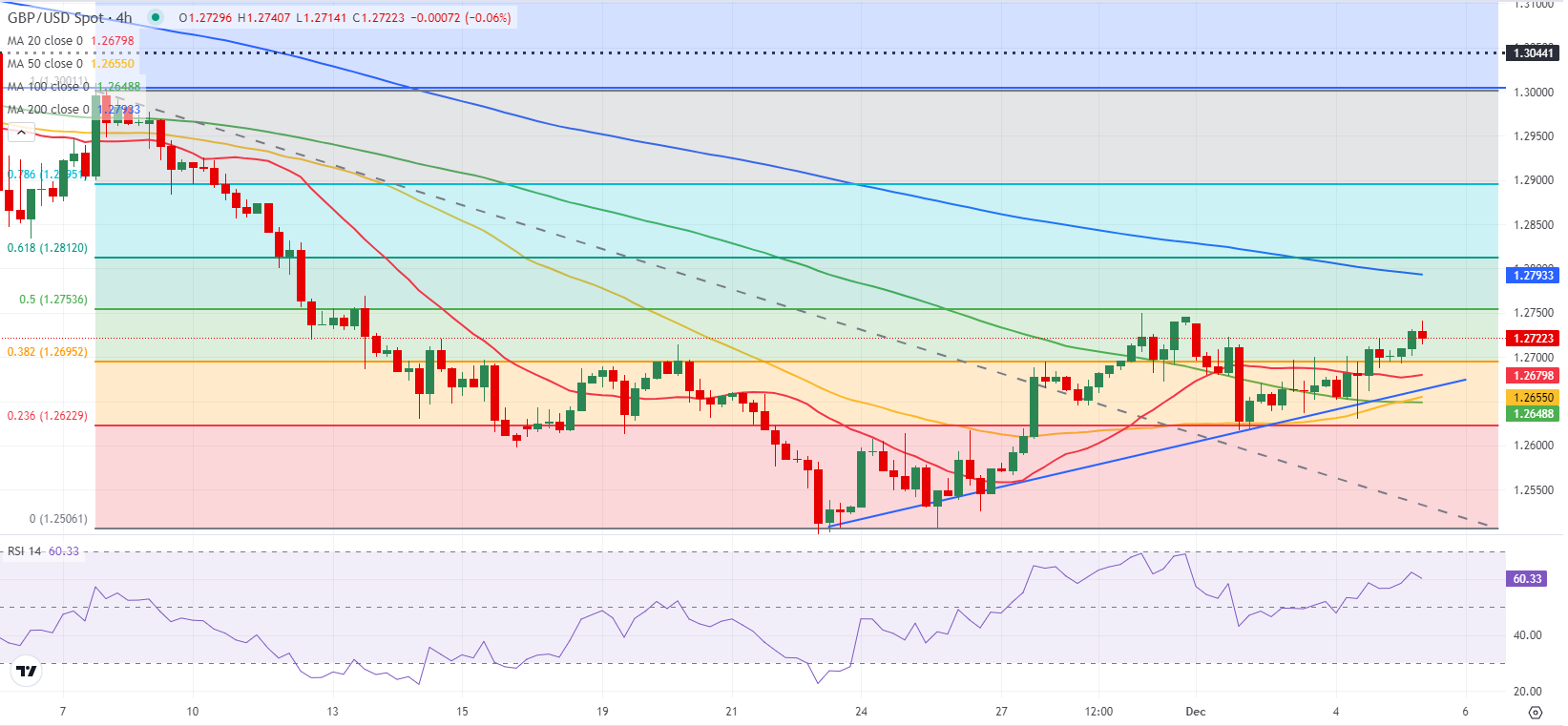- GBP/USD holds above 1.2700 in the European session on Thursday.
- The pair could stretch higher if it clears 1.2750 resistance.
- GBP/USD's upside could remain capped in case markets turn cautious.
GBP/USD registered small gains for the second consecutive day on Wednesday and continued to edge higher early Thursday. The technical outlook suggests that the bullish bias remains intact in the near term.
British Pound PRICE This week
The table below shows the percentage change of British Pound (GBP) against listed major currencies this week. British Pound was the strongest against the Australian Dollar.
| USD | EUR | GBP | JPY | CAD | AUD | NZD | CHF | |
|---|---|---|---|---|---|---|---|---|
| USD | 0.46% | 0.13% | 0.41% | 0.51% | 1.14% | 1.02% | 0.46% | |
| EUR | -0.46% | -0.38% | -0.05% | 0.06% | 0.77% | 0.55% | 0.05% | |
| GBP | -0.13% | 0.38% | 0.31% | 0.43% | 1.15% | 0.92% | 0.37% | |
| JPY | -0.41% | 0.05% | -0.31% | 0.12% | 0.77% | 0.62% | -0.00% | |
| CAD | -0.51% | -0.06% | -0.43% | -0.12% | 0.79% | 0.49% | -0.06% | |
| AUD | -1.14% | -0.77% | -1.15% | -0.77% | -0.79% | -0.23% | -0.77% | |
| NZD | -1.02% | -0.55% | -0.92% | -0.62% | -0.49% | 0.23% | -0.52% | |
| CHF | -0.46% | -0.05% | -0.37% | 0.00% | 0.06% | 0.77% | 0.52% |
The heat map shows percentage changes of major currencies against each other. The base currency is picked from the left column, while the quote currency is picked from the top row. For example, if you pick the British Pound from the left column and move along the horizontal line to the US Dollar, the percentage change displayed in the box will represent GBP (base)/USD (quote).
Falling US Treasury bond yields and disappointing macroeconomic data releases from the US made it difficult for the US Dollar (USD) to stay resilient against its major rivals on Wednesday. The ISM Services PMI declined to 52.1 in November from 56 in October and missed the market expectation of 55.5. Additionally, the ADP Employment Change came in at 146,000 in November, compared to analysts' estimate of 150,000.
In the meantime, EUR/GBP closed in negative territory for the sixth consecutive day on Wednesday, suggesting that Pound Sterling continued to capture capital outflows out of the Euro.
In the early American session on Thursday, the US Department of Labor will release the weekly Initial Jobless Claims. Ahead of Friday's Nonfarm Payrolls (NFP) data, however, the market reaction to this data is likely to remain short-lived. Instead, investors could react to changes in risk perception. At the time of press, US stock index futures were trading mixed. In case safe-haven flows dominate the action in financial markets later in the day, GBP/USD could struggle to push higher.
GBP/USD Technical Analysis
The Relative Strength Index (RSI) indicator on the 4-hour chart holds comfortably above 50 and GBP/USD trades above the ascending trend line, reflecting the bullish bias.
On the upside, 1.2750 (Fibonacci 50% retracement of the latest downtrend) could be seen as next resistance before 1.2790-1.2800 (Fibonacci 61.8% retracement, 200-period SMA) and 1.2850 (static level). On the downside, immediate support is located at 1.2700 (Fibonacci 38.2% retracement) ahead of 1.2650 (100-period Simple Moving Average) and 1.2620 (Fibonacci 23.6% retracement).
Pound Sterling FAQs
The Pound Sterling (GBP) is the oldest currency in the world (886 AD) and the official currency of the United Kingdom. It is the fourth most traded unit for foreign exchange (FX) in the world, accounting for 12% of all transactions, averaging $630 billion a day, according to 2022 data. Its key trading pairs are GBP/USD, also known as ‘Cable’, which accounts for 11% of FX, GBP/JPY, or the ‘Dragon’ as it is known by traders (3%), and EUR/GBP (2%). The Pound Sterling is issued by the Bank of England (BoE).
The single most important factor influencing the value of the Pound Sterling is monetary policy decided by the Bank of England. The BoE bases its decisions on whether it has achieved its primary goal of “price stability” – a steady inflation rate of around 2%. Its primary tool for achieving this is the adjustment of interest rates. When inflation is too high, the BoE will try to rein it in by raising interest rates, making it more expensive for people and businesses to access credit. This is generally positive for GBP, as higher interest rates make the UK a more attractive place for global investors to park their money. When inflation falls too low it is a sign economic growth is slowing. In this scenario, the BoE will consider lowering interest rates to cheapen credit so businesses will borrow more to invest in growth-generating projects.
Data releases gauge the health of the economy and can impact the value of the Pound Sterling. Indicators such as GDP, Manufacturing and Services PMIs, and employment can all influence the direction of the GBP. A strong economy is good for Sterling. Not only does it attract more foreign investment but it may encourage the BoE to put up interest rates, which will directly strengthen GBP. Otherwise, if economic data is weak, the Pound Sterling is likely to fall.
Another significant data release for the Pound Sterling is the Trade Balance. This indicator measures the difference between what a country earns from its exports and what it spends on imports over a given period. If a country produces highly sought-after exports, its currency will benefit purely from the extra demand created from foreign buyers seeking to purchase these goods. Therefore, a positive net Trade Balance strengthens a currency and vice versa for a negative balance.
Information on these pages contains forward-looking statements that involve risks and uncertainties. Markets and instruments profiled on this page are for informational purposes only and should not in any way come across as a recommendation to buy or sell in these assets. You should do your own thorough research before making any investment decisions. FXStreet does not in any way guarantee that this information is free from mistakes, errors, or material misstatements. It also does not guarantee that this information is of a timely nature. Investing in Open Markets involves a great deal of risk, including the loss of all or a portion of your investment, as well as emotional distress. All risks, losses and costs associated with investing, including total loss of principal, are your responsibility. The views and opinions expressed in this article are those of the authors and do not necessarily reflect the official policy or position of FXStreet nor its advertisers. The author will not be held responsible for information that is found at the end of links posted on this page.
If not otherwise explicitly mentioned in the body of the article, at the time of writing, the author has no position in any stock mentioned in this article and no business relationship with any company mentioned. The author has not received compensation for writing this article, other than from FXStreet.
FXStreet and the author do not provide personalized recommendations. The author makes no representations as to the accuracy, completeness, or suitability of this information. FXStreet and the author will not be liable for any errors, omissions or any losses, injuries or damages arising from this information and its display or use. Errors and omissions excepted.
The author and FXStreet are not registered investment advisors and nothing in this article is intended to be investment advice.
Recommended Content
Editors’ Picks

EUR/USD soars past 1.1200 as China's tariffs confirmed at 145%
EUR/USD soared beyond 1.1200 amid headlines confirming the latest round of tariffs, levies on Chinese imports reached 145%. Wall Street collapses amid renewed concerns that Trump's policies will hit the American economy. Soft US inflation data released earlier in the day adds to the broad US Dollar's weakness.

GBP/USD closes in to 1.3000 on renewed USD selling
GBP/USD resumed its advance and nears the 1.3000 mark, as speculative interest resumed US Dollar selling. Softer than anticipated US CPI figures and persistent tensions between Washington and Beijing over trade weigh on the American currency and Wall Street.

Gold resumes record rally, reaches $3,175
Gold extended its record rally on fresh tariff-related headlines, trading as high as $3,175 a troy ounce in the American session. The White House confirmed 35% levies on Mexico and Canada, 145% on Chinese imports, resulting in a fresh round of USD selling and pushing XAU/USD further up.

Cardano stabilizes near $0.62 after Trump’s 90-day tariff pause-led surge
Cardano stabilizes around $0.62 on Thursday after a sharp recovery the previous day, triggered by US Donald Trump’s decision to pause tariffs for 90 days except for China and other countries that had retaliated against the reciprocal tariffs announced on April 2.

Trump’s tariff pause sparks rally – What comes next?
Markets staged a dramatic reversal Wednesday, led by a 12% surge in the Nasdaq and strong gains across major indices, following President Trump’s unexpected decision to pause tariff escalation for non-retaliating trade partners.

The Best brokers to trade EUR/USD
SPONSORED Discover the top brokers for trading EUR/USD in 2025. Our list features brokers with competitive spreads, fast execution, and powerful platforms. Whether you're a beginner or an expert, find the right partner to navigate the dynamic Forex market.
